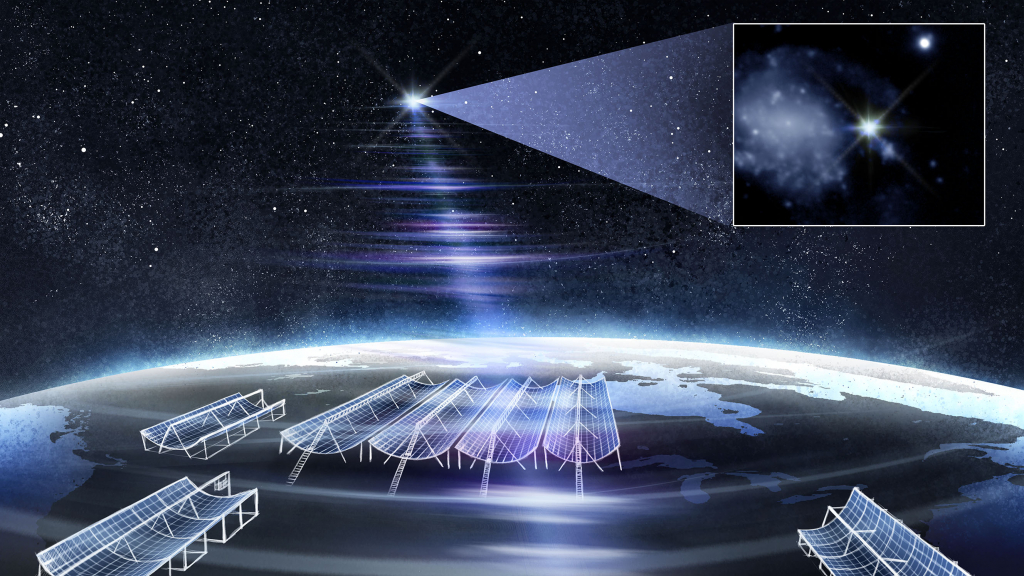The U.S. National Science Foundation National Radio Astronomy Observatory (NSF NRAO), in partnership with several leading Mexican universities and research institutes, has announced a series of landmark agreements and meetings aimed at advancing Mexico’s role in the Next Generation Very Large Array (ngVLA) project.
Recent News
Astronomers Discover a Superheated Star Factory in the Early Universe
Astronomers have uncovered a previously unknown, extreme kind of star factory by taking the temperature of a distant galaxy using the ALMA telescope. The galaxy is glowing intensely in superheated cosmic dust while forming stars 180 times faster than our own Milky Way.
Astronomers Share Largest Molecular Survey To-date: GOTHAM Legacy Data Goes Public
Astronomers in the “GBT Observations of TMC-1: Hunting Aromatic Molecules” research survey, known as GOTHAM, have released a spectral line survey with largest amount of telescope time ever conducted, charting more than 100 molecular species only found in deep space.
Brightest Ever Fast Radio Burst Allows Researchers To Identify Its Origin

Astronomers use newly deployed telescopes and deep-space imaging to challenge long-held assumptions about what causes these mysterious cosmic signals
An international team of astronomers have observed one of the brightest fast radio bursts (FRBs) ever detected—and pinpointed its location in a nearby galaxy (NGC 4141). FRB 20250316A has been nicknamed RBFLOAT, which stands for Radio Brightest FLash Of All Time. The finding and the discovery of the location surprised the team and revealed new insight into FRBs, which are one of astrophysics’ biggest mysteries.
FRBs are powerful, millisecond-long flashes of radio waves from space. Researchers suspect that they are the result of extreme cosmic events but have, so far, been unable to determine their exact origin. FRBs are notoriously difficult to study because they vanish in the blink of an eye.
This discovery was made using the Canadian Hydrogen Intensity Mapping Experiment (CHIME), one of the premier instruments used to study FRBs, along with data from NASA’s JWST. One of CHIME’s telescopes (also called outriggers) is located in the National Radio Quiet Zone on the campus of the U.S. National Science Foundation Green Bank Observatory. This outrigger is one of several CHIME telescopes distributed across North America, which also includes locations in British Columbia and California, designed to work together for very long baseline interferometry (VLBI). A co-author on the paper, Fengqiu Adam Dong, is a Jansky Fellow based at the NSF Green Bank Observatory.
The Green Bank Outrigger, combined with the rest of the array, allowed researchers to triangulate RBFLOAT’s position with extremely high spatial resolution, down to tens of milliarcseconds, which corresponds to approximately 13 parsecs (or 45 light-years) at the FRB’s distance.
This news was adapted from press releases from several institutions involved with this research, including McGill University and the Center for Astrophysics | Harvard & Smithsonian.
This news article was originally published on the NRAO website on August 21, 2025.
Recent News
NSF National Radio Astronomy Observatory and Mexican Institutions Sign Historic Agreements to Advance ngVLA Collaboration
The U.S. National Science Foundation National Radio Astronomy Observatory (NSF NRAO), in partnership with several leading Mexican universities and research institutes, has announced a series of landmark agreements and meetings aimed at advancing Mexico’s role in the Next Generation Very Large Array (ngVLA) project.
Astronomers Discover a Superheated Star Factory in the Early Universe
Astronomers have uncovered a previously unknown, extreme kind of star factory by taking the temperature of a distant galaxy using the ALMA telescope. The galaxy is glowing intensely in superheated cosmic dust while forming stars 180 times faster than our own Milky Way.
Astronomers Share Largest Molecular Survey To-date: GOTHAM Legacy Data Goes Public
Astronomers in the “GBT Observations of TMC-1: Hunting Aromatic Molecules” research survey, known as GOTHAM, have released a spectral line survey with largest amount of telescope time ever conducted, charting more than 100 molecular species only found in deep space.
